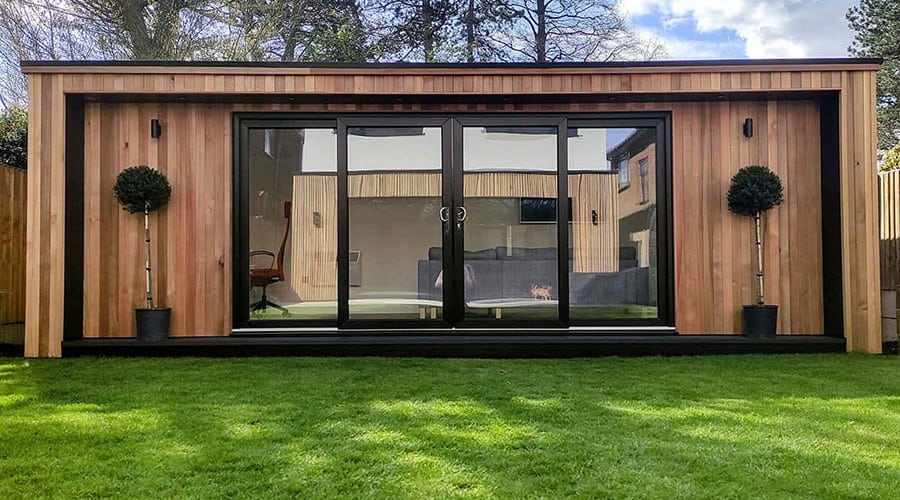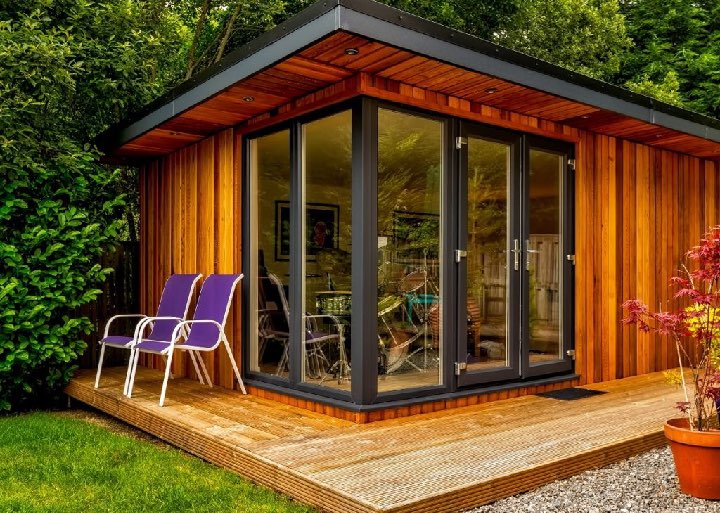Recommended Tips For Planning Permission On Garden Buildings
Wiki Article
What Are The Dimensions Restrictions For Garden Rooms?
Size restrictions on specific areas will usually determine whether planning permission is required for extensions to garden rooms, extension, conservatories outhouses. Here's a list of common size-related criteria that might need you to obtain permission to plan: Total Area Coverage:
Planning permission is usually required for a detached outbuilding when its total area, including any existing outbuildings and the surrounding area house exceeds 50 percent.
Height Restrictions:
Single-story buildings The maximum height of the eaves cannot exceed 2.5 meters. The overall height should not exceed 4 meters in the case of a dual-pitched roof or 3 meters for other kind of roof.
A building that is less than 2 meters away from the property's boundary should not be more than 2.5 meters in size.
Floor Area:
Building regulations could be necessary for structures with greater floor space than 30 sqm, even when planning permission is not required.
Proximity to boundaries
If the building is not more than 2 meters away from a border, a planning permit is required if the structure's height exceeds 2.5 metres.
Building Usage
It's not a strictly defined size limit, however the intended use for the garden space could affect the requirement for planning permission. If the intended use of the space is residential accommodation, or a commercial space, planning approval is likely to be required.
Permitted Development Rights:
Permitted Development Rights apply specific restrictions on size and conditions. These rights vary based on whether the property is in a protected area or subjected to other limitations.
Conservatories or Extensions
The maximum depth of an one-story rear extension typically is 4 meters for detached houses, and 3 metres in semi-detached homes or terraced houses. Under the Neighbour consultation scheme, these may be increased to 8 meters or 6 meters respectively.
The rear extension on a single-story house cannot be taller than 4 metres.
Side Extensions:
The maximum height for a side extension shouldn't exceed 4 meters.
Volume Restrictions:
In some areas, like conservation zones, or Areas of Outstanding Natural Beauty Any addition to the original building which is greater than 10% or increases the size by 50 cubic meters may require planning consent.
Front Extenders
Extensions that extend beyond the front of the house that faces the road may require planning permission.
Contact your local authorities as the rules may vary depending on local councils and the conditions of your property. If no planning approval is required, approval in accordance with the building regulations might be needed for structural integrity or safety reasons. Take a look at the best garden room maximum height for site examples including garden rooms near me, outhouse building, copyright garden room, my outhouse, garden rooms hertfordshire, best electric heater for cabin, ground screws vs concrete base, what size garden room without planning permission, garden rooms, outhouse garden rooms and more.

What Planning Permissions Are Required For Gardens, Rooms, Etc. In Terms Of The Height Limit?
The height of garden rooms and conservatories, as well as outhouses, office buildings, or extensions will determine if or not a planning permit is required. Here are the key factors to be aware of: General Height Limits:
A detached outbuilding, or an extension with an incline roof (such as a gable) must not be taller than 4 meters.
If you have a flat roofing, a single-pitched roof, or any other type of roof, the height limit cannot exceed 3 meters. For any other type (flat, single pitched, etc. ) the height maximum should not exceed three meters.
Proximity to Boundaries
The maximum height of a structure that is not more than 2 meters from the boundary must not exceed 2.5 meters. This applies to garages, sheds, as well as similar structures.
Eaves Height
The maximum height of the eaves (the space between the smallest portion of the roof and eaves) cannot exceed 2.5 metres for any building.
Extensions and conservatories:
For an extension of a single story, the height cannot be more than 4 meters. Included in this is the roof, as well as any walls that are parapet.
Side Extensions
Extensions on the sides should not exceed 4 metres and no wider than 50% of the original size of the home.
Special Roofs
Structures with a flat roof are typically limited to a maximum height of 3 meters.
Additional restrictions on areas designated for specialization
In designated conservation zones, Areas of Outstanding Natural Beauty and other designated areas there may be higher height limits and permits are required for structures that otherwise would be permitted.
Constructions in National Parks
National Parks can have height restrictions similar to those in designated areas. Planning permission is required.
Roof Design:
Height of highest part of roof (excluding chimneys and antennas) It is important to consider. Planning permission is needed if your high point is greater than the maximum development allowed.
The effect on neighbors:
Even if a structure falls within the permitted height limit the planning permit may be required if the structure significantly impacts the sunlight, privacy or view of neighbouring properties.
Maximum Height:
The total height of a structure should not exceed 4 metres. A garden office that has roofing that is dual-pitched, for instance can't be taller than 4 meters.
Decking or Platforms
To prevent the requirement for planning permission, any platforms or decks part of the structure must not elevate the level of ground by more 0.3 meters.
It's always advisable to consult your local planning authority to inquire about specific rules and recent changes to regulations. Even if a development is in the scope of allowed rights of development, local modifications or particular property requirements may require permission for planning. See the top garden office near me for more advice including outhouse for garden, luxury outhouse, copyright outbuildings, outhouse, garden office electrics, composite garden office, outhouses for garden, garden room planning permission, 4m x 4m garden room, garden rooms and more.

Regarding Location Restrictions What Type Of Planning Permission Are You Required To Build Gardens?
If you're planning to build gardens, conservatories and outhouses, gardens offices, or extensions, location restrictions play a crucial part in determining if planning permission is needed. Here are the most important criteria for location closeness to boundaries:
Within 2 meters of your property border, any structure should not exceed 2.5 meters. If the height exceeds this limit the planning permission has to be obtained.
Front of the property
Planning permission is typically required for any structure that is that are built on the front of a home's primary elevation (the side facing the front) as the permitted development rights do not allow for extensions that go forward.
Right-hand side of the property:
Side extensions have to adhere to specific size and height restrictions and often require permission for planning if they extend beyond the side wall of the house.
Rear of the property
There are height and size limits for rear extensions. If they exceed the permissible boundaries for development, the planning permission must be sought out.
Designated Areas
In National Parks, World Heritage Sites and Areas of Outstanding Natural Beauty there are stricter rules. Every new building may require planning approval, no matter the size.
Listed Buildings
Property that is listed as a building has strict rules. Any construction or alteration will require planning consent and approval of listed buildings, regardless its place of construction.
Green Belt Land:
Green belt land is heavily restricted to preserve the open space. A special permit is typically required for any new construction or major alterations.
Flood-prone Areas
Additional regulations can be imposed when the property being inspected is located within a flood-prone area. These are designed to prevent the building of a new building from increasing the risk of flooding. You might need planning permission and perhaps an assessment of flood risk.
Urban vs. Rural Settings:
Urban and rural areas have different rules. Rural homes, for instance, may have more lax restrictions on the placement and dimensions of outbuildings. But, this may differ widely.
Highways, Public Rights of Way and Public Rights of Way
If the structure is close to highways, roads or public rights-of-ways, planning approval may be required to stop obstruction to safety, view, or accessibility.
Shared Ownership and Leasehold Land
If you have a home that is leasehold or part of a shared ownership scheme it is possible to obtain additional approval from the property owner or managing entity. You may also need planning permission depending on the local laws.
In the vicinity of other structures:
It could be necessary to seek planning permission when a new structure is going to be constructed close to the existing buildings or structures, especially on neighbouring property. This will ensure that the building or land adjacent to it is not negatively affected.
For advice regarding your particular property's conditions and location, it's best to speak to your local planning authority. The regulations vary widely based on the local laws. Compliance with all relevant restrictions can aid in avoiding legal issues and possible fines. See the top heaters for summer houses for website tips including garden buildings , garden room conservatory, best electric heater for cabin, garden room heater, garden office, composite garden rooms, composite garden office, composite summer house, outhouse garden rooms, best electric heater for cabin and more.
